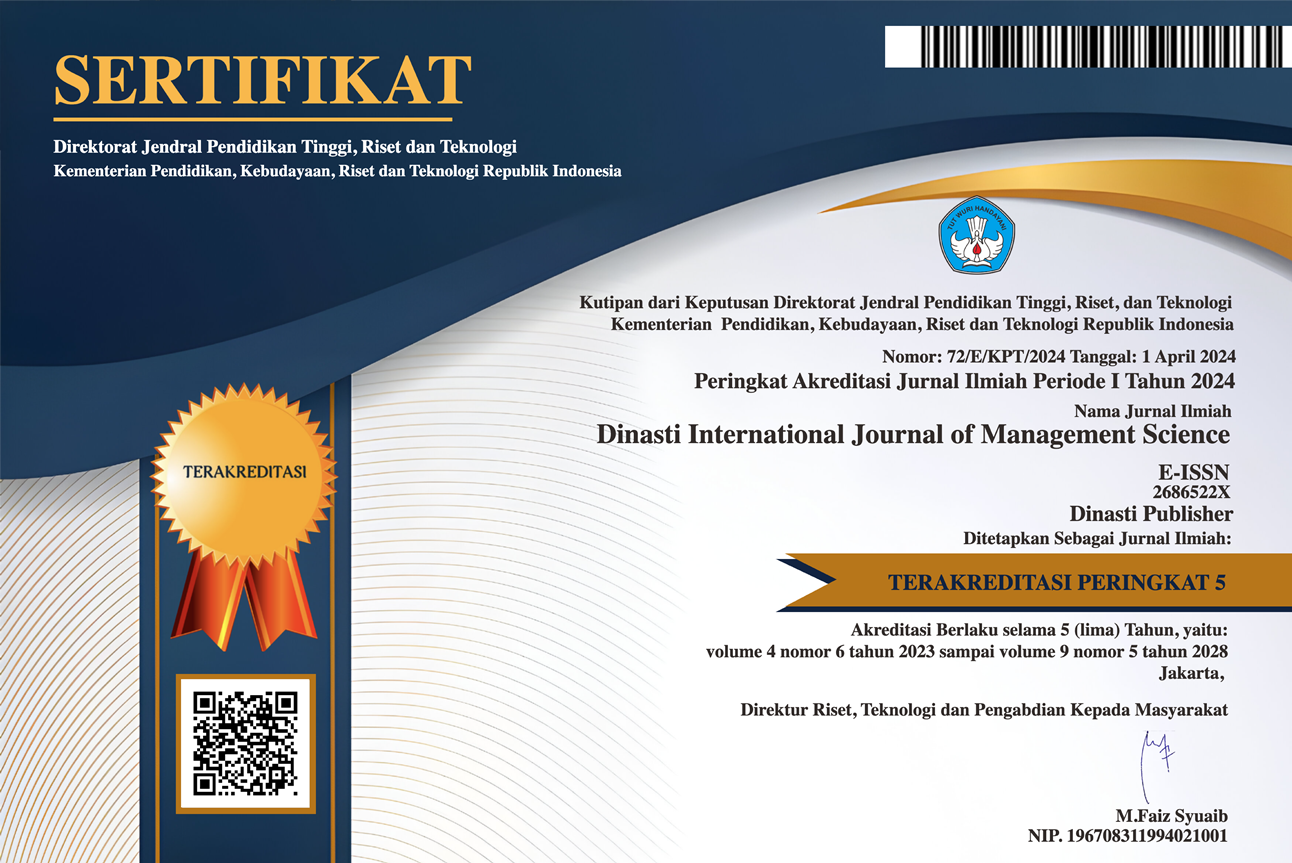Strategies to Prevent Employee Turnover: Implementation Program Employee Engagement & Employee Retention
DOI:
https://doi.org/10.38035/dijms.v6i1.2988Keywords:
Employee Turnover, Employee Engagement, Employee RetentionAbstract
The purpose of this scientific article is to provide qualitative insights and descriptions that the variables related to employee engagement, employee turnover and employee retention are important for organizations to be used as a foundation, as well as for other interests. Qualitative research methods can provide valuable insights in analyzing employee engagement, employee retention, and employee turnover. A qualitative approach is focused on understanding an individual's experiences, perceptions, and behaviors and can help uncover the reasons and motivations behind them. One approach in qualitative research in this context can be done through in-depth interviews with employees to explore their perceptions of the factors that affect employee engagement, employee retention, and employee turnover, the strategies implemented must be holistic, involve various dimensions of human resource management, and be directed to create a work environment that motivates and supports career development and overall employee well-being.
References
Aggarwal, A., Jaisinghani, D. and Nobi, K. (2022). Effect of organizational justice and support on organizational commitment and employee turnover intentions: the mediating role of employee engagement, International Journal of Quality and Service Sciences, 14(4), pp. 525–554.
Allen, D.G., Bryant, P.C. and Vardaman, J.M. (2010). Retaining talent: Replacing misconceptions with evidence-based strategies. Academy of management Perspectives, 24(2), pp. 48–64.
Allen, D.G. and Vardaman, J.M. (2021). Global talent retention: Understanding employee turnover around the world. in Global talent retention: understanding employee turnover around the world. Emerald Publishing Limited, pp. 1–15.
Bartlomiejczuk, G. (2015). How do Recognition Programs Impact Employee Engagement and How have Companies with a Large Global Footprint Structured such Programs to Drive Results. in. Available at: https://api.semanticscholar.org/CorpusID:166960667.
Bergman, A., David, G. and Song, H. (2023). “I Quit”: Schedule Volatility as a Driver of Voluntary Employee Turnover. Manuf. Serv. Oper. Manag., 25, pp. 1416–1435. Available at: https://api.semanticscholar.org/CorpusID:257575390.
Chandani, A. et al. (2016). Employee engagement: A review paper on factors affecting employee engagement. Indian Journal of Science and Technology, 9(15), pp. 1–7.
Cognitions, T. and Paillé, P. (2015). Retention: Examining The Relationships Between Organizational Citizenship, 31(4), pp. 1437–1452.
Dale-Olsen, H. (2016). Employee turnover. in Research handbook on employee turnover. Edward Elgar Publishing, pp. 5–25.
Dr P Hameem Khan Priyalakshmi. P, V.. J.L.B. (2024). Explore How Organizations Can Utilize Marketing Techniques To Enhance Employee Engagement. Journal of Informatics Education and Research [Preprint]. Available at: https://api.semanticscholar.org/CorpusID:269255951.
Dwesini, N.F. and Sisulu, W. (2019). Causes and prevention of high employee turnover within the hospitality industry?: A literature review. in. Available at: https://api.semanticscholar.org/CorpusID:203617671.
Eldor, L. and Vigoda-Gadot, E. (2017). The nature of employee engagement: Rethinking the employee–organization relationship. The International Journal of Human Resource Management, 28(3), pp. 526–552.
Fulmore, J.A. et al. (2023). Reducing employee turnover intentions in the service sector: The connection between human resource development practices and employee engagement. Human Resource Development Quarterly, 34(2), pp. 127–153.
Ghani, B. et al. (2022). Challenges and strategies for employee retention in the hospitality industry: A review. Sustainability, 14(5), p. 2885.
Gomathy, D.. K. (2022). Employee Engagement Strategies In Information Technology Companies. International Journal Of Scientific Research In Engineering And Management [Preprint]. Available at: https://api.semanticscholar.org/CorpusID:247652287.
Habarurema, A. (2016). Effect of motivational system on productivity of employees in private universities. a case study of marist international university college (MIUC). Strategic Journal of Business & Change Management [Preprint]. Available at: https://api.semanticscholar.org/CorpusID:56293980.
Hausknecht, J.P., Rodda, J. and Howard, M.J. (2009). Targeted employee retention: Performance?based and job?related differences in reported reasons for staying. Human Resource Management: Published in Cooperation with the School of Business Administration, The University of Michigan and in alliance with the Society of Human Resources Management, 48(2), pp. 269–288.
Juliantara, I.K., Sihombing, I.H.H. and Sulistyawati, N.L.K.S. (2020). The effect of employee engagement on turnover intention. in The International Conference on Business and Management Research (ICBMR 2020). Atlantis Press, pp. 300–305.
Kang, M. and Sung, M. (2019). To leave or not to leave: the effects of perceptions of organizational justice on employee turnover intention via employee-organization relationship and employee job engagement. Journal of Public Relations Research, 31(5–6), pp. 152–175.
Konovalova, V.G. (2021). Employee Recognition Programs: Experience and New Reality. Management of the Personnel and Intellectual Resources in Russia [Preprint]. Available at: https://api.semanticscholar.org/CorpusID:237737239.
Kossivi, B., Xu, M. and Kalgora, B. (2016). Study on determining factors of employee retention. Open Journal of Social Sciences, 4(05), p. 261.
Kumar, S. (2021). The impact of talent management practices on employee turnover and retention intentions. Global Business and Organizational Excellence [Preprint]. Available at: https://api.semanticscholar.org/CorpusID:236400092.
Luo, C.-C., Wang, Y.-C. and Tai, Y.-F. (2019). Effective training methods for fostering exceptional service employees. Journal of Hospitality and Tourism Insights, 2(4), pp. 469–488.
Al Mamun, C.A. and Hasan, M.N. (2017). Factors affecting employee turnover and sound retention strategies in business organization: A conceptual view. Problems and Perspectives in Management, (15, Iss. 1), pp. 63–71.
Mamun, C.A. Al and Hasan, M.N. (2017). Factors affecting employee turnover and sound retention strategies in business organization: A conceptual view. Problems and Perspectives in Management, 15(1), pp. 63–71. Available at: https://doi.org/10.21511/ppm.15(1).2017.06.
Molahosseini, I.S. et al. (2020). The Influence of Organizational Aesthetics on Employee Retention and Turnover Intentions From Organization. Management Theory and Studies for Rural Business and Infrastructure Development, 42(2), pp. 171–177. Available at: https://doi.org/10.15544/mts.2020.17.
Natalia, J. and Rosiana, E. (2011). Analisa Pengaruh Employee Engagement Terhadap Kinerja Karyawan Dan Turnover Intention. Journal of Physics A: Mathematical and Theoretical, 44(8), pp. 93–105.
Naufer, Z. and Kumar, S. (2020). Impact of Employee Engagement on Turnover Intention: Study of Third Space Global (Pvt) Limited. Kelaniya Journal of Human Resource Management, 15, pp. 1–71. Available at: https://doi.org/10.4038/kjhrm.v15i1.73.
Norizan, N.S., Ismail, I. and Hamzah, M.I. (2022). Sustainability In The Malaysian Food And Beverage Industry: Managing Employee Retention Through Perceived Organisational Support And Turnover Intention. Journal of Sustainability Science and Management, 17(9), pp. 29–43.
Pareek, A., Mohanty, S.S. and Mangaraj, S. (2019). Systematic review on employee engagement and its impact on employee retention.
Parmenas, N.H. (2022). Employee Engagement: Turn Over Prevention Strategies And The Key To Improving Performance Management In A Multinational Company. Journal of Economics, Management, Entrepreneurship, and Business (JEMEB) [Preprint]. Available at: https://api.semanticscholar.org/CorpusID:250228157.
Pavlovi?, G. (2018). Employer Attractiveness and the Employee Turnover and Retention. pp. 806–811. Available at: https://doi.org/10.31410/itema.2018.806.
Raza, M. and Nadeem, S. (2018). Drivers of Employee Engagement and their Impact on Job Satisfaction and Turnover Intentions. Journal of Managerial Sciences, 12(2).
Rea, L.M. and Parker, R.A. (2014). Designing and conducting survey research: A comprehensive guide. John Wiley & Sons.
Rony, Z.T., Suharjuddin, S. and Aryanto, S. (2021). The Role of Human Resources Management Builds Knowledge Management in the Situation of Increasing Employees Voluntary Turnover (Case study in the Production Division of an Indonesian National Private Television Company 2019-2020). Proceedings of the 2nd Borobudur International Symposium on Humanities and Social Sciences, BIS-HSS 2020, 18 November 2020, Magelang, Central Java, Indonesia [Preprint]. Available at: https://api.semanticscholar.org/CorpusID:242488656.
Saks, A.M. and Gruman, J.A. (2014). What do we really know about employee engagement?. Human resource development quarterly, 25(2), pp. 155–182.
Salleh, R. and Memon, M.A. (2015). A review on the effects of pay satisfaction on employee engagement and turnover: a proposed mediating framework. International Business Management, 9(3), pp. 344–348.
Saputra, I.W.A. and Suwandana, I.G.M. (2022). Employee Engagement and Compensation on Employee Turnover Intention at a Local Café and Bar in Bali, Indonesia. European Journal of Business and Management Research, 7(1), pp. 329–332.
Shuck, B. et al. (2014). Human resource development practices and employee engagement: Examining the connection with employee turnover intentions. Human resource development quarterly, 25(2), pp. 239–270.
Singh, S. and Sant, S. (2023). The Moderating Role of Workplace (Hybrid/Remote) on Employee Engagement and Employee Turnover Intention. Employee responsibilities and rights journal, pp. 1–16.
Stray, V. and Moe, N.B. (2020). Understanding coordination in global software engineering: A mixed-methods study on the use of meetings and Slack. Journal of Systems and Software, 170, p. 110717.
Thirupathy, A. and Dhayalan, C. (2016). 532 (I2or) Retention and Turnover Using Motivational Variables At India. International Journal of Research-Granthaalayah, 4(8), pp. 1–11. Available at: https://doi.org/10.5281/zenodo.60688.
Wulansari, P., Meilita, B. and Ganesan, Y. (2020). The effect of employee retention company to turnover intention employee—Case study on head office Lampung bank. in 3rd Global Conference on Business, Management, and Entrepreneurship (GCBME 2018). Atlantis Press, pp. 236–239.
Downloads
Published
How to Cite
Issue
Section
License
Copyright (c) 2024 Primadi Candra Susanto, Kamsariaty Kamsariaty, Jatmiko Murdiono, Nuraeni Nuraeni, Erni Pratiwi Perwitasari

This work is licensed under a Creative Commons Attribution 4.0 International License.
Authors who publish their manuscripts in this journal agree to the following conditions:
- The copyright on each article belongs to the author(s).
- The author acknowledges that the Dinasti International Journal of Management Science (DIJMS) has the right to be the first to publish with a Creative Commons Attribution 4.0 International license (Attribution 4.0 International (CC BY 4.0).
- Authors can submit articles separately, arrange for the non-exclusive distribution of manuscripts that have been published in this journal into other versions (e.g., sent to the author's institutional repository, publication into books, etc.), by acknowledging that the manuscript has been published for the first time in the Dinasti International Journal of Management Science (DIJMS).
















































